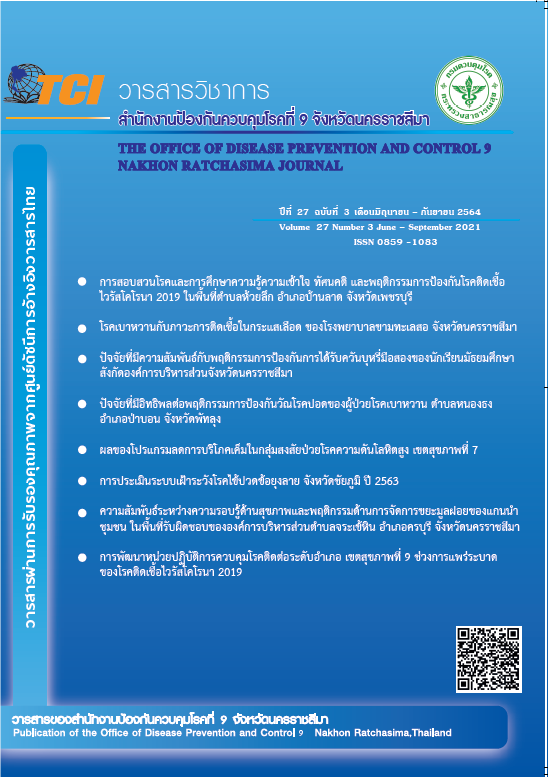Factors associated with Protective Behavior of Secondhand Smoking among Students in Secondary Schools under taking Nakhon Ratchasima Provincial Administration Organization
Keywords:
Secondhand smoke, Protective behavior, Secondary school studentsAbstract
This research aimed to study the prevention behavior of secondhand smoke exposure and factors associated with secondhand smoke prevention behavior among secondary school students under taking the Nakhon Ratchasima Provincial Administrative organization. Total 405 students who were studying in secondary school students under the Nakhon Ratchasima Provincial Administrative organization were collected the data by questionnaire. The data were analysed by descriptive statistics presented by number, percentage, mean, maximum, minimum and standard deviation. Relationship was analysed by using multiple logistic regression statistics. The results found that the most of students had adequate levels of secondhand smoke prevention behavior (84.94%). The factors associated with the students’ secondhand smoke prevention behavior found that the female students had the behaviour were 1.68 times higher than male students (AOR = 1.68; 95% CI: 1.12-2.52; p-value = 0.013). The students who were aware of the threatening conditions in secondhand smokers were 1.70 times higher than the ones who had not been aware (AOR = 1.70; 95% CI: 1.10-2.71; p-value = 0.026). The students who were expected to be aware of preventing second hand smokers in adequate level were 1.64 times higher than the group of inadequate level (AOR = 1.64; 95% CI: 1.10-2.49; p-value= 0.019). This can be used as basic information for policy making, planning, implementation, prevention, monitoring and problem solving. The school should hold activities to raise awareness of the threat of secondhand smoking. Continuously recognizing the expectations of preventing the use of secondhand smoking for students and enhancing awareness through channels suitable for appropriate daily lifestyle.
References
สำนักงานกองทุนสนับสนุนการสร้างเสริมสุขภาพ. ผลของควันบุหรี่มือสองต่อสุขภาพของผู้ที่ได้รับควันบุหรี่
[ออนไลน์]. เข้าถึงเมื่อ 28 พฤศจิกายน 2562 จาก https://www.thaihealth.or.th/Content/42932. 2561.
สำนักงานกองทุนสนับสนุนการสร้างเสริมสุขภาพ. ควันบุหรี่มือสอง ภัยจากบุหรี่ที่เราไม่ได้สูบ. [ออนไลน์]. เข้าถึงเมื่อ 28 พฤศจิกายน 2562 จาก https://www.thaitobacco.or.th/th/2015/01/006812.html. 2560.
รุ่งราวี ทองกันยา และสุนิดา ปรีชาวงษ์. ปัจจัยทำนายพฤติกรรมการหลีกเลี่ยงการได้รับควันบุหรี่มือสองของผู้ป่วยโรคเรื้อรังในกรุงเทพมหานคร. กรุงเทพฯ: จุฬาลงกรณ์มหาวิทยาลัย; 2556.
ศูนย์วิจัยและจัดการความรู้เพื่อการควบคุมยาสูบ. การทบทวนวรรณกรรม “บ้านปลอดบุหรี่”. กรุงเทพฯ.เจริญดีมั่นคงการพิมพ์; 2560.
Rosenstock. I.M. The Health Belief Model and Prevention Behavior. Health Education Monographs, 1994; 2 : 354-385.
Harold O Kiess. Statistical Concepts for The Behavioral Sciences. Biston Allyn and Bacon; 1989.
บัณฑิต ถิ่นคำรพ. คู่มือปฏิบัติการชีวสถิติ: สำหรับศึกษาชีวสถิติด้วยตนเอง. ขอนแก่น. โรงพิมพ์คลังนานาวิทยา. 2540.
จักรพันธ์ เพ็ชรภูมิ และคณะ. ปัจจัยที่มีผลต่อพฤติกรรมหลีกเลี่ยงการได้รับควันบุหรี่มือสองของนักศึกษาในมหาวิทยาลัยแห่งหนึ่ง. วารสารสาธารณสุขมหาวิทยาลัยบูรพา 2561; 13(2): 89-101.
สนอง คล้ำฉิม. ความสัมพันธ์ระหว่างการรับรู้อันตรายจากควันบุหรี่มือสองกับพฤติกรรมสุขภาพของสมาชิกครอบครัวที่มีผู้สูบบุหรี่. นครปฐม: มหาวิทยาลัยศิลปากร; 2551.

Downloads
Published
How to Cite
Issue
Section
License
บทความที่ลงพิมพ์ในวารสารวิชาการสำนักงานป้องกันควบคุมโรคที่ 9 จังหวัดนครราชสีมา ถือว่าเป็น
ลิขสิทธิ์ สำนักงานป้องกันควบคุมโรคที่ 9 จังหวัดนครราชสีมา



